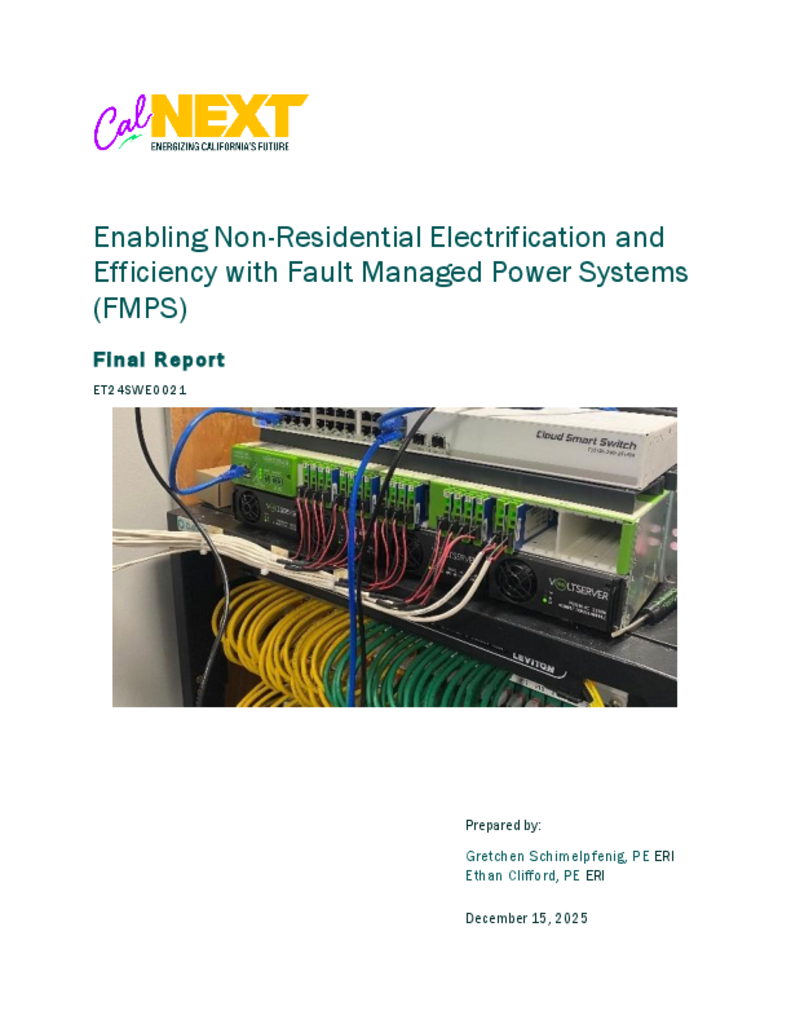ET24SWE0021 - Enabling Non-Residential Electrification and Efficiency with Fault Managed Power Systems (FMPS)
This project will explore market potential and assess how Fault Managed Power Systems (FMPS) can reduce the barriers to electrification efforts by reducing the complexity and cost of electrical infrastructure upgrades across non-residential (commercial, industrial, and agricultural) customer segments. This project will explore the FMPS market potential and associated individual technologies to better understand the landscape and program impacts with an interest to scale the market for commercial, industrial, and agricultural systems. With the rising need for widespread electrification of buildings in California, innovative solutions are needed to support broad decarbonization efforts.
FMPS technology capitalizes on providing direct current (DC) power to DC-powered devices, reducing line losses over long distances via efficient power delivery. This then provides simpler, lower-cost electrical infrastructure that enables the electrification of space heating, water heating, foodservice, and electric vehicle charging infrastructure. This also provides energy savings through high-efficiency power distribution and flexible demand management. FMPS reduces barriers to installing new electrical distribution by lowering cost and complexity of installing new power distribution. FMPS uses an entirely separate power distribution pathway (communication cable) to overcome physical space constraints within cities.
The project team will investigate the percentage of buildings currently using FMPS, market penetration of technology, and energy savings potential for increased adoption of FMP technology. The assessment will leverage existing literature reviews, surveys, interviews with experienced practitioners, and site visits to assess the potential for energy efficiency (EE) technologies that can achieve significant energy savings in new and existing buildings with FMP technology. The project team will conduct a demonstration to identify FMP technology ability to generate demand reductions, energy savings, and to support new measures eligible for EE programs. Based on the data collected, the project team will create a technology roadmap that will assess FMPS technologies for further field assessments, pilots, work paper development, and go-to-market strategies for existing program channels. The roadmap will be produced based on an in-depth analysis of the highest potential technologies to identify market barriers and intervention strategies to address these barriers.
The Non-Residential Electrification and Efficiency with Fault-Managed Power Systems (FMPS) CalNEXT project explored the technology's market potential and assessed how FMPS can reduce barriers to electrification efforts by reducing the complexity and cost of electrical infrastructure upgrades across non-residential (commercial, industrial, and agricultural) customer segments. This project characterized associated individual technologies to better understand the landscape and program impacts with an interest in scaling the market for commercial, industrial, and agricultural systems. With the rising need for widespread electrification of buildings in California, innovative solutions are needed to support broad decarbonization efforts.
FMPS technology capitalizes on providing direct current (DC) power to DC-powered devices, reducing line losses over long distances via efficient power delivery. The team installed an FMPS system at one indoor farm in California to evaluate the energy savings potential of FMPS for horticultural lighting process systems and uncover a strategic direction for FMPS program development. These systems observed energy and environmental data for four weeks to confirm lighting system operation during a flowering cannabis growth cycle.
The Project Team observed that electrical infrastructure with a higher power factor has lower potential FMPS energy savings. It was also noted that FMPS has the potential to achieve 5 percent electricity savings in indoor agriculture process lighting applications. The indoor cannabis industry could save 71 million kWh across 9,500,000 square feet of cultivation facilities with FMPS-powered horticultural lighting. Customer insights from the study showed FMPS is easier to implement in new construction projects or phased retrofits of large buildings. The insights support considerations for creating new inducement payments for FMPS through new construction programs to encourage new construction projects to adopt Class 4 Power while electrifying other building systems.

